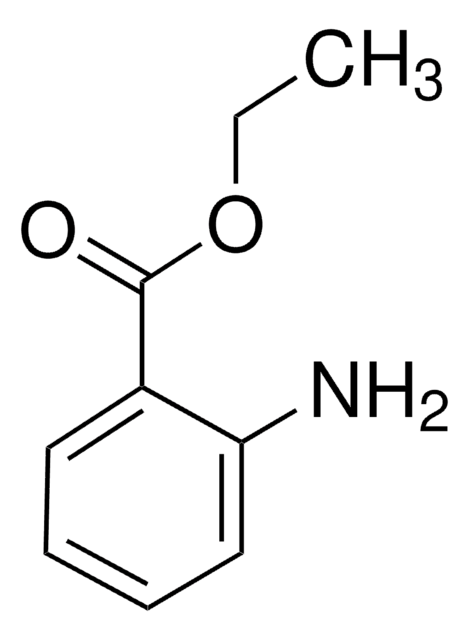Kluczowe dokumenty
236454
Methyl 2-aminobenzoate
ReagentPlus®, ≥99%
Synonim(y):
Methyl anthranilate
About This Item
Polecane produkty
ciśnienie pary
1 mmHg ( 20 °C)
Poziom jakości
linia produktu
ReagentPlus®
Próba
≥99%
Postać
liquid
temp. samozapłonu
986 °F
współczynnik refrakcji
n20/D 1.582 (lit.)
tw
256 °C (lit.)
mp
24 °C (lit.)
rozpuszczalność
alcohol: freely soluble(lit.)
diethyl ether: freely soluble(lit.)
water: slightly soluble(lit.)
gęstość
1.168 g/mL at 25 °C (lit.)
grupa funkcyjna
ester
ciąg SMILES
COC(=O)c1ccccc1N
InChI
1S/C8H9NO2/c1-11-8(10)6-4-2-3-5-7(6)9/h2-5H,9H2,1H3
Klucz InChI
VAMXMNNIEUEQDV-UHFFFAOYSA-N
Szukasz podobnych produktów? Odwiedź Przewodnik dotyczący porównywania produktów
Opis ogólny
Zastosowanie
Informacje prawne
Hasło ostrzegawcze
Warning
Zwroty wskazujące rodzaj zagrożenia
Zwroty wskazujące środki ostrożności
Klasyfikacja zagrożeń
Eye Irrit. 2
Kod klasy składowania
10 - Combustible liquids
Klasa zagrożenia wodnego (WGK)
WGK 1
Temperatura zapłonu (°F)
262.4 °F - closed cup
Temperatura zapłonu (°C)
128 °C - closed cup
Środki ochrony indywidualnej
Eyeshields, Gloves, type ABEK (EN14387) respirator filter
Wybierz jedną z najnowszych wersji:
Masz już ten produkt?
Dokumenty związane z niedawno zakupionymi produktami zostały zamieszczone w Bibliotece dokumentów.
Klienci oglądali również te produkty
Nasz zespół naukowców ma doświadczenie we wszystkich obszarach badań, w tym w naukach przyrodniczych, materiałoznawstwie, syntezie chemicznej, chromatografii, analityce i wielu innych dziedzinach.
Skontaktuj się z zespołem ds. pomocy technicznej









